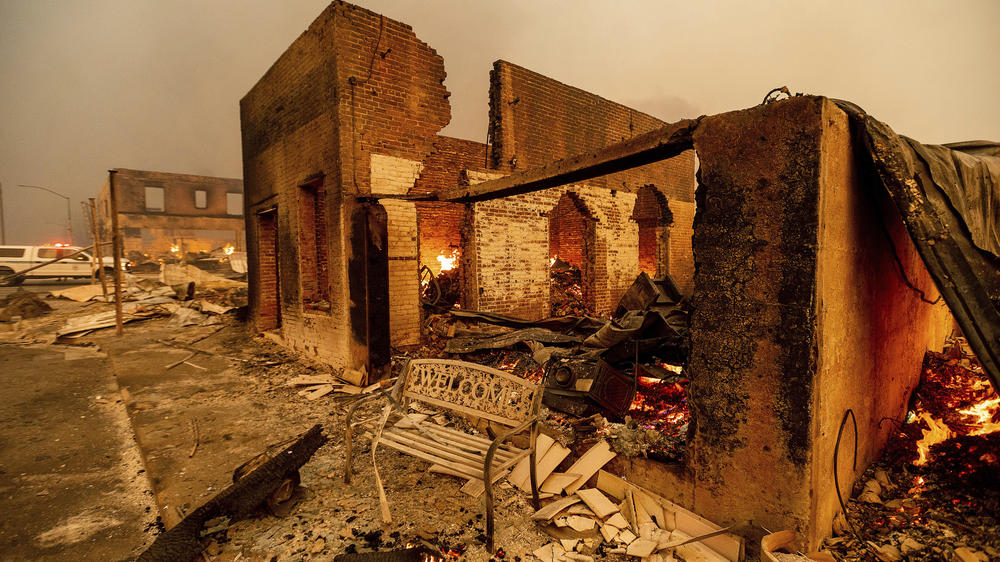Section Branding
Header Content
Dixie Fire Stirs Anxiety In The California Town Decimated In 2018 By The Camp Fire
Primary Content
Out-of-control wildfires in northern California are burning homes and again forcing thousands to evacuate.
One of the biggest concerns remains the Dixie Fire, the second largest wildfire in the U.S. It has now burned some 322,000 acres, including much of the northern Sierra Nevada town of Greenville.
Until recently, the Dixie Fire had been burning in mostly remote wild lands. But that changed dramatically Wednesday as erratic winds sent the flames racing toward whole communities around the popular vacation enclave of Lake Almanor.
By late afternoon, an ominous emergency alert broke into local radio here warning all Greenville, Calif., residents to leave immediately.
"We lost Greenville tonight," said U.S. Rep. Doug LaMalfa in an emotional video to his constituents posted to Facebook. "There's just no words for how us in government haven't been able to get the job done."
Only a dramatic change in the weather will stop wildfires like this in an era of climate change. They're also burning through dense, overgrown forests built up from a legacy of suppressing fires. The Dixie Fire is the latest to rage in this mostly rural part of the Sierra Nevada that's been traumatized by huge and deadly wildfires since 2018.
"It started at the same place the Camp Fire did, that's all people needed to hear," says Steve Crowder, the mayor of Paradise, Calif.
His community is still reeling from the Camp Fire in November of 2018, which killed 85 people and destroyed close to 19,000 structures. The Dixie Fire started in the same area, also likely due to downed power lines.
"It really is tough on people," Crowder says. "It just brings back all kinds of memories."
Paradise is actually pretty safe — for now
The huge, volcano-like plume of the Dixie Fire can be seen from out the back of Paradise town hall, though so far it's burning away from it. But people who have moved back in, like Stephen Murray, know that could easily change. Paradise is about 15 miles as the crow flies from where the Dixie Fire started and is still burning.
"Last Thursday, I had my truck packed and I was ready to leave. Even though I rebuilt my home and all that, it's not worth staying," Murray says. He didn't end up leaving for good though, for now. He's been making a living as a contractor, clearing out debris from burnt out lots. But it's so dry he can only operate machinery in the early morning due to the threat of sparks igniting more fires.
"Unfortunately the Dixie Fire has put me out of work for the last 20 days," Murray says.
In the hot afternoon sun obscured by dense smoke, he looks nervously at his neighbor's abandoned property, overgrown with dry brush.
But even if the Dixie Fire were to blow back this way, the irony is that Paradise today is actually pretty safe, for now. New power lines are being buried underground. Homes are being built to more fire resistant code. And most of the forests are gone because thousands of trees had to be removed.
"This is a safer community and quite honestly one of the safest in the Sierra," says Jim Broshears, a longtime wildland fire chief who now runs the town's emergency services.
Residents have their bags packed so they're ready to leave if they have to
This is of little solace to the thousands of Camp Fire survivors who decided to leave Paradise and put their lives back together elsewhere.
Linda and Bob Oslin moved to a home about 30 minutes away from Paradise after losing everything in the Camp Fire. They were evacuated due to wildfires last summer and figure it's only a matter of time before they'll have to leave again.
They have suitcases packed and their essential documents are already in a pickup outside.
"I have my suitcase ready to go and I just live out of my suitcase," Linda says. "This is our life from ... May to December."
The Oslins know this could soon be their life year round as wildfire "seasons" are now a relic of the cooler past.
Copyright 2021 NPR. To see more, visit https://www.npr.org.


